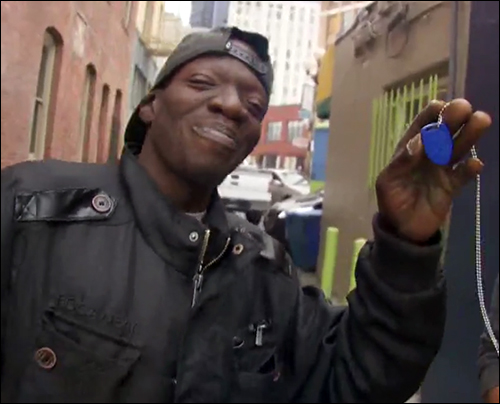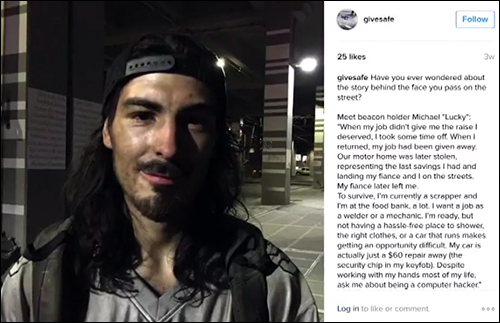Since August of this year, charity-based technology startup GiveSafe has distributed 70 Bluetooth Low Energy (BLE) beacons to individuals living on the streets of Seattle. The beacons, as well as an app provided by GiveSafe, enable residents and commuters to identify when a homeless person is near, to read about his or her life story and anonymously provide a monetary contribution. The homeless person can then redeem that donation by presenting the beacon for food or personal supplies at participating stores.
GiveSafe started as a concept by Jonathan Kumar, the company’s founder. Kumar had already founded FoodCircles, in Michigan, which provides “Buy one, feed one” vouchers from participating restaurants via a website. Users buy a voucher, then visit that restaurant, purchase their own meal and contribute the voucher to feed a hungry person. Kumar wanted to see, however, if there was a way to further help those in need. He envisioned a system that could make the public aware of the homeless around them, by providing their stories to create a picture of each individual and how he or she ended up in that situation. The same system would also (in Kumar’s concept) enable people to make anonymous contributions to the homeless without having to directly engage with them.
The system Kumar developed is intended as an alternative to the existing status quo, in which city residents and workers typically pass homeless people on the street without noticing them. In addition, Kumar says, the goal is to reduce the number of interactions in which the homeless approach potentially reluctant passersby for handouts.
GiveSafe was launched this summer in Seattle with an Android– and iOS-based app, as well as content-management software hosted on GiveSafe’s server to manage beacon transmission data and payment distribution. The company acquired BLE beacons to be worn by the homeless.
The beacon-based GiveSafe solution allows Seattleites to anonymously donate to a specific individual, learn about his or her story, and approach that person if they so desire. “Most people who give feel uncomfortable engaging with an individual and want to be anonymous,” explains Andrei Villasana, the company’s software engineer. By using the GiveSafe system, members of the public can provide help without interacting directly with recipients. But conversely, he says, for those who do want to interact, the app offers that opportunity as well. For instance, an app user who connects with a specific individual’s life story may want to speak with that person. The BLE technology enables the user to know when that individual is near, and to find that person based on the alert and his or her photograph.
The company distributed 70 Gimbal beacons on lanyards to the indigent. As each homeless individual received the beacon, a GiveSafe employee took a picture of that person and input his or her story. That information and photo were then linked to the unique ID number being transmitted by that person’s beacon, and were loaded onto the app. Those who live or work in Seattle can download the free app to access information about the local homeless population. As long as an app user has Bluetooth functionality enabled, the phone can respond to transmissions from the beacons.
When a phone running the app comes within approximately 30 yards of a beacon (the distance of a typical city block), it sounds an alert to let the app user know that a GiveSafe homeless person is nearby. The user can then open the app and view who it is. If that person has already selected specific homeless people to help, he or she can also be alerted only about those individuals.
Once the alert is received, if the app user would then like to make a donation, he or she can select an amount to pay, and send that payment to GiveSafe’s content-management software, via the app, using an Apple Pay, PayPal or credit card account.
If the homeless person associated with a beacon has a smartphone, he or she can receive an alert via a text message or e-mail that a donation has been made, as well as the amount. An individual who lacks access to phone or e-mail can take the beacon to a participating store that is using the app at its point of sale (POS). There, stores have a tablet or phone running the POS version of the GiveSafe app. Workers can scan the beacon using the BLE-enabled device, and thus view the balance of that individual’s account.
The homeless person can select food or other necessary items to purchase at the store and carry them to the cash register. An employee again scans the beacon, the purchase is completed and the amount of the transaction is deducted from that individual’s account. GiveSafe then automatically reimburses the store for the amount of the purchase.
The solution started small, Villasana says, with only 70 homeless beacon wearers, but next year, the company intends to raise the number of beacons in use to 500. The system was recently broadcast on King 5 News in Seattle, at which time the number of app downloads grew from 1,200 to 2,400.
The company earns its profit by charging a stipend for each donation. For instance, a $1 donation can come with a 15-cent transaction fee. “This has been a great opportunity for me,” says Villasana (who is still a college student), to use his technology education to benefit the homeless. “A lot of homeless individuals are shunned by society, and GiveSafe allows them to share their story.”
According to Villasana, the system has proven not only to improve the lives of the beacon-wearing participants monetarily, but also to boost their morale. “It’s not just about money,” he says. “It’s about encouraging them to see new opportunities, to give them hope.” The homeless can redeem the beacons at a barber shop, for instance, to receive a haircut to improve their appearance and, therefore, their chance of succeeding at a job interview.
GiveSafe’s long-term goal, Villasana says, is to expand the system’s use to other cities throughout the United States.
This is not the first radio frequency identification system intended to help the homeless. In 2013, a group of researchers worked together under the name Patchworks to develop an RFID solution to remind the indigent of appointments with doctors, social workers or housing agencies. The team developed a shoebox-size device containing a Raspberry Pi low-cost computer, an RFID reader and a small printer, similar to that in an electronic cash register (see Meet PAT, Siri for the Homeless).
Images courtesy of King 5 News.




